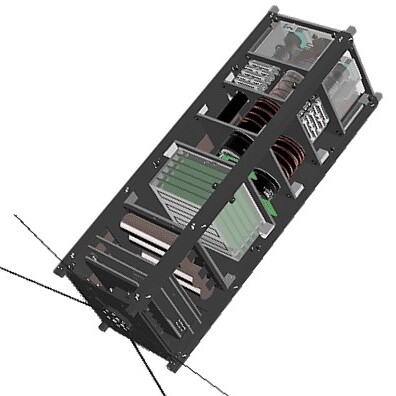SpaceICE ("Interface Convective Effects") CubeSat Mission
Kristen Scotti, Chelsea Ye, Lawrence Luo, Bohan Yao, *Dominic Herincx, *Jessica Li, *Robert Lundberg, *Teddy Broeren, *Andy McIntosh, and *Lauren Kearney
in collaboration with University of Illinois at Urbana-Champaign and Bradley University
*researcher graduated/completed assignment
Interface Convective Effects (SpaceICE) is a 3U CubeSat mission designed to investigate freeze-casting in the microgravity environment of Low Earth Orbit (LEO). Freeze-casting is a directional solidification technique that is used to fabricate porous materials with anisotropic, aligned pore structures. The overarching goal of the SpaceICE mission is to improve terrestrial fabrication of these materials by building a better fundamental understanding of processing/microstructure relationships in freeze-casting materials and producing benchmark data to enable improved modeling efforts of the solidification process.
The SpaceICE mission is driven primarily by undergraduate students and is made possible by a partnership between Northwestern University (NU), the University of Illinois at Urbana-Champaign (UIUC), and Bradley University (BU), and by support from NASA's Office of Education through the Undergraduate Student Instrument Project.
At Northwestern, we are designing the experiment and payload, while UIUC (CubeSat Project) is building the satellite. The SpaceICE payload includes two identical particle suspensions and one solution system, each of which will be directionally solidified and thawed repeatedly over the course of the mission. In-situ temperature and image data will be collected during solidification experiments and compared to control studies (1g) in an effort to elucidate the effect of gravity on freeze-casting microstructures templated during solidification.

Fig. 1. CAD model of the SpaceICE satellite showing the scientific payload.
Related Publications
- Scotti, K.L. & Dunand, D.C. (2017). Freeze Casting: A review of processing, microstructure and properties via the open data repository, FreezeCasting.net. Submitted to: Progress in Materials Science.
- Scotti, K.L., Northard, E.E., Plunk, A., Tappan, B.C., & Dunand, D.C. (2017). Directional solidification of aqueous TiO2 suspensions under reduced gravity. Acta Materialia, 124, 608-619.
- Scotti, K. L., Kearney, L. G., Burns, J., Ocana, M., Duros, L., Shelhamer, A., & Dunand, D. C. (2019). The effect of solidification direction with respect to gravity on ice-templated TiO2 microstructures. Journal of the European Ceramic Society, 39(10), 3180-3193.
Funding Support
- NASA Office of Education
- NASA Science Mission Directorate
